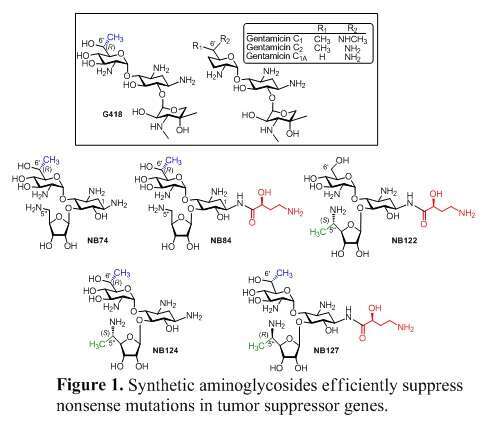
Characterization of new-generation aminoglycoside promoting premature termination codon readthrough in cancer cells
2Université Pierre et Marie Curie, Paris, France
3Institute for Integrative Biology of the Cell (I2BC), CEA, CNRS, Université Paris-Sud, Paris, France
Nonsense mutations, generating premature termination codons (PTCs), account for 10% to 30% of the mutations in tumor suppressor genes. Nonsense translational suppression, induced by small molecules including gentamicin and G418, has been suggested as a potential therapy to counteract the deleterious effects of nonsense mutations in several genetic diseases and cancers. The NB compounds tested here, NB74, NB84, NB122, NB124 and NB127 (Figure 1), all contain structural components derived from paromomycin and G418, but were designed to suppress PTCs more efficiently and with lower toxicity than conventional aminoglycosides. It was found that NB124, a synthetic aminoglycoside derivative recently developed especially for PTC suppression, strongly induces apoptosis in human tumor cells by promoting high level of PTC readthrough. Using a reporter system, we showed that NB124 suppressed several of the PTCs encountered in tumor suppressor genes, such as the p53 and APC genes. We also showed that NB124 counteracted p53 mRNA degradation by nonsense mediated decay. Both PTC suppression and mRNA stabilization contributed to the production of a full-length p53 protein capable of activating p53-dependent genes, thereby specifically promoting high levels of apoptosis. This new-generation aminoglycoside thus outperforms the only clinically available readthrough inducer (gentamicin). These results have important implications for the development of personalized treatments of PTC-dependent diseases and for the development of new drugs modifying translation fidelity.

Powered by Eventact EMS